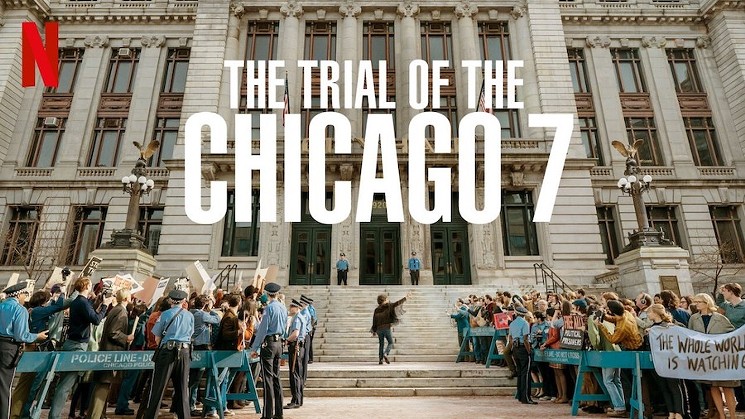To say we live in chaotic times is an understatement. Our country faces a polarizing presidential election against the intense influence of a deadly pandemic and a national fight against racial injustice.
In 1968, our country also faced a defining presidential election amid a fight for civil rights. The powerful The Trial of the Chicago 7 speaks to us now, looking at our nation’s present through the lens of the past. Based on historical events, the Netflix drama about the aftermath of the violent riots at the 1968 Democratic National Convention is one of the most important films of the year.
Initially, a peaceful protest outside of the the1968 Democratic National Convention, the demonstration quickly turned violent when protestors clashed with surrounding law enforcement. A disjointed team of anti-Vietnam War activists was blamed for the escalation of the protests and deemed enemies to the government by the media. The movie follows these seven men as they navigate their way through national attention and the injustices of the American legal system.
Even though the defendants barely knew one another, the activists, Abbie Hoffman, Jerry Rubin, Tom Hayden, and Bobby Seale were charged with conspiracy and crossing over state lines to incite a riot. The trial, which lasted from March 20, 1969, to February 20, 1970, was one of the most notorious in history- a landmark case for American civil liberties.
The Trial proceedings are very intense with incredibly high stakes. The defendants claimed that they were in Chicago to peacefully protest the unnecessary deaths of the Vietnam War and that they were provoked by an out-of-control police force, while the prosecution argued that the events were the result of careful planning and malicious intent. After months of dramatic testimony, the trial finally came to a close on day 151.
The Trial of the Chicago 7 minimizes the use of flashbacks and instead employs great editing and compelling dialogue to add life to this courtroom drama. While it’s tempting to use flashbacks in a film like this, it’s important to focus on the trial itself and use the flashbacks as tools of suspense, flashing back to key moments before, during, and after the convention. Additionally, the movie attempted to add authenticity by combining real footage of the Chicago 7 and their trial with original interviews and trial transcripts in the dialogue.
Unfortunately, many creative liberties were used during the writing of this film. Some of the dialogue is directly from court transcripts, but a lot of the events were embellished or invented to create a more comprehensible sequence of events. Other changes such as the random addition of the undercover F.B.I agent, however, had no useful purpose and diluted the richness of the true story.
Any time a story from history is retold, one fundamental question must be answered: Why now? This question could not be answered any clearer with the release of The Trial of the Chicago 7. It brings emotion and humanity to a moment which despite passing quickly into history, is still so relevant. This isn’t a perfect movie. However, the film strikes a powerful note, sadly reminding us that not much has changed in 50 years. Overall, “The Trial of the Chicago 7” truly excels at bringing this infamous trial to light.
